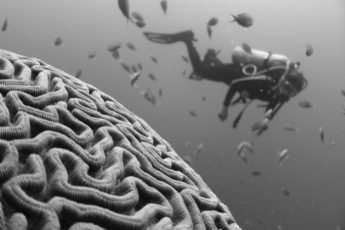Normally one part of the brain communicates with other parts through a network of chemical connections relayed by neurotransmitters. Communication is almost instantaneous between the billions of cells in the brain. However, that level of connection is impaired during and after a trauma. In order to de-escalate the brain from the fight or flight state and the associated sympathetic body response, the brain represses the trauma memory into what is essentially an enclosed memory system that contains the trauma. This enclosed state is analogous to a house with no driveway or access to roads that lead elsewhere, no telephone wires, cables, books, mail, or even satellite connections. Introduction of new information changes the receiver, so the rate of change to those living in such a house nears stagnation. They are seemingly frozen in time. The enclosed memory system of trauma is similarly frozen and, when triggered, replays the trauma memory as if it were occurring in the present. Typically, four components of the trauma memory are stored in the enclosed memory system:
1. The negative perception of oneself, (“I am helpless”, “I am bad”, “I am in danger”, “I have no control”, etc.)
2. Disturbing emotions, (fear, horror, guilt, hurt, anger, etc.)
3. The felt experience of those emotions in one’s body, (lump in throat, nausea, tight muscles, a heaviness in the chest, etc.)
4. Some element of the five senses, (image, sound, taste, smell, or tactile sensation)
EMDR targets these four elements of the frozen trauma, creating a connection to the rest of the brain, thus processing the trauma. It does this by mimicking the brain’s natural processing ability. During the REM stage of sleep, the eyes move back and forth while the sleeper dreams, thereby activating both sides of the brain creating bilateral stimulation (BLS). This BLS is essential to processing the day’s events because it, in essence, generates new brain connections. An extensive sleep study done by Sturpenich et al. (2014) states that REM, “essentially foster[s] progressive integration [of memories/experiences] into existing semantic knowledge stored in cortical circuits” [i.e., the brain]. In layman’s terms, this study, (among others), shows that REM sleep strengthens new memories and generalizes them to already existing related memories. It stands to reason that this generalization occurs due to increased interaction or connection.
In addition, just as the digestive system purges waste and utilizes good nutrients, REM sleep clears much of the negative perceptions of that day’s experiences and keeps helpful positive perceptions. This is what EMDR does as well. The difference between EMDR and REM sleep is that REM sleep cannot access the enclosed trauma memory systems. But because EMDR specifically targets the four components of the enclosed trauma memory it can access and thus process the trauma.
To sum it up, EMDR is based on the Adaptive Information Processing (AIP) model (Shapiro, 2009). The hypotheses of this model include:
1. People have internal means to adaptively process new information.
2. The information stored in one’s memory networks is related and is in the form of thoughts and some form of the above mentioned five senses, image, sound, taste, smell, tactile sensation.
3. New memories, including trauma memories, are associated with earlier, similar memories stored in the brain.
4. When a person experiences trauma, or when their early developmental needs are not met, the brain’s natural ability to process this information, or new similar trauma experiences, to an adaptive state is impaired.
5. Unprocessed trauma results in dysfunctional responses to everyday stimuli.
6. When information is adaptively processed, new information is learned, emotional and body stress is relieved, and subsequently, one has more internal access to adaptive responses to life events.
Shapiro. F. (2009) The EMDR approach to Psychotherapy: EMDR Institute Basic Training Course. 119.
Sterpenich. V., Schmidt. C., Albouy. G., Matarazzo. L., Vanhaudenhuyse. A., Boveroux. P., Degueldre. C., Leclercq. Y., Balteau. E., Collette. F., Luxen. A., Phillips. C., Maquet. P. (2014). Memory Reactivation during Rapid Eye Movement Sleep Promotes Its Generalization an Integration in Cortical Stores. Sleep, 37(6). 1061–1075.




